Mabo vs Queensland and Kartinyeri vs Commonwealth: A Comparison
VerifiedAdded on 2022/12/22
|16
|4780
|7
Essay
AI Summary
This essay provides a comparative analysis of two landmark constitutional law cases in Australia: Mabo v Queensland and Kartinyeri v Commonwealth. The essay begins by introducing the Mabo case, which overturned the doctrine of terra nullius and recognized native title. It then outlines the facts and legal arguments presented in the case, including the claims of the Meriam people and the Queensland government's defense. Subsequently, the essay contrasts Mabo with the Kartinyeri case, focusing on the legal issues surrounding the Hindmarsh Island bridge and the limitations of section 51 of the Australian Constitution. The essay highlights the similarities and differences between the two cases, particularly concerning land ownership and the application of constitutional law. It also addresses the key questions raised by the courts in both cases, such as the rights of Aboriginal people and the interpretation of relevant constitutional provisions. Finally, the essay identifies the legal principles enunciated in each case, emphasizing their significance in shaping Australian law regarding indigenous land rights and constitutional interpretation. This essay provides valuable insights into the evolution of Australian constitutional law and its impact on indigenous communities.
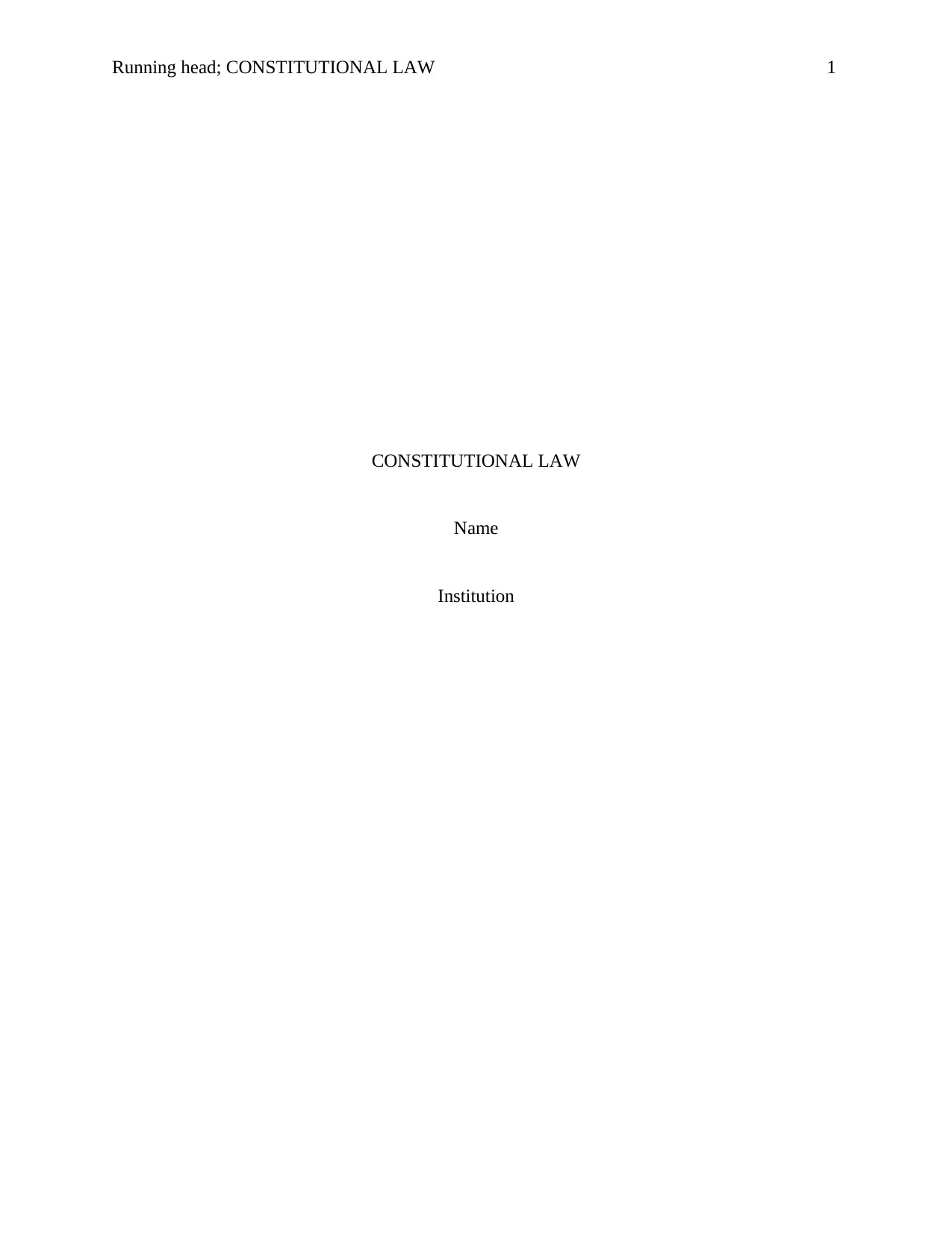
Running head; CONSTITUTIONAL LAW 1
CONSTITUTIONAL LAW
Name
Institution
CONSTITUTIONAL LAW
Name
Institution
Paraphrase This Document
Need a fresh take? Get an instant paraphrase of this document with our AI Paraphraser
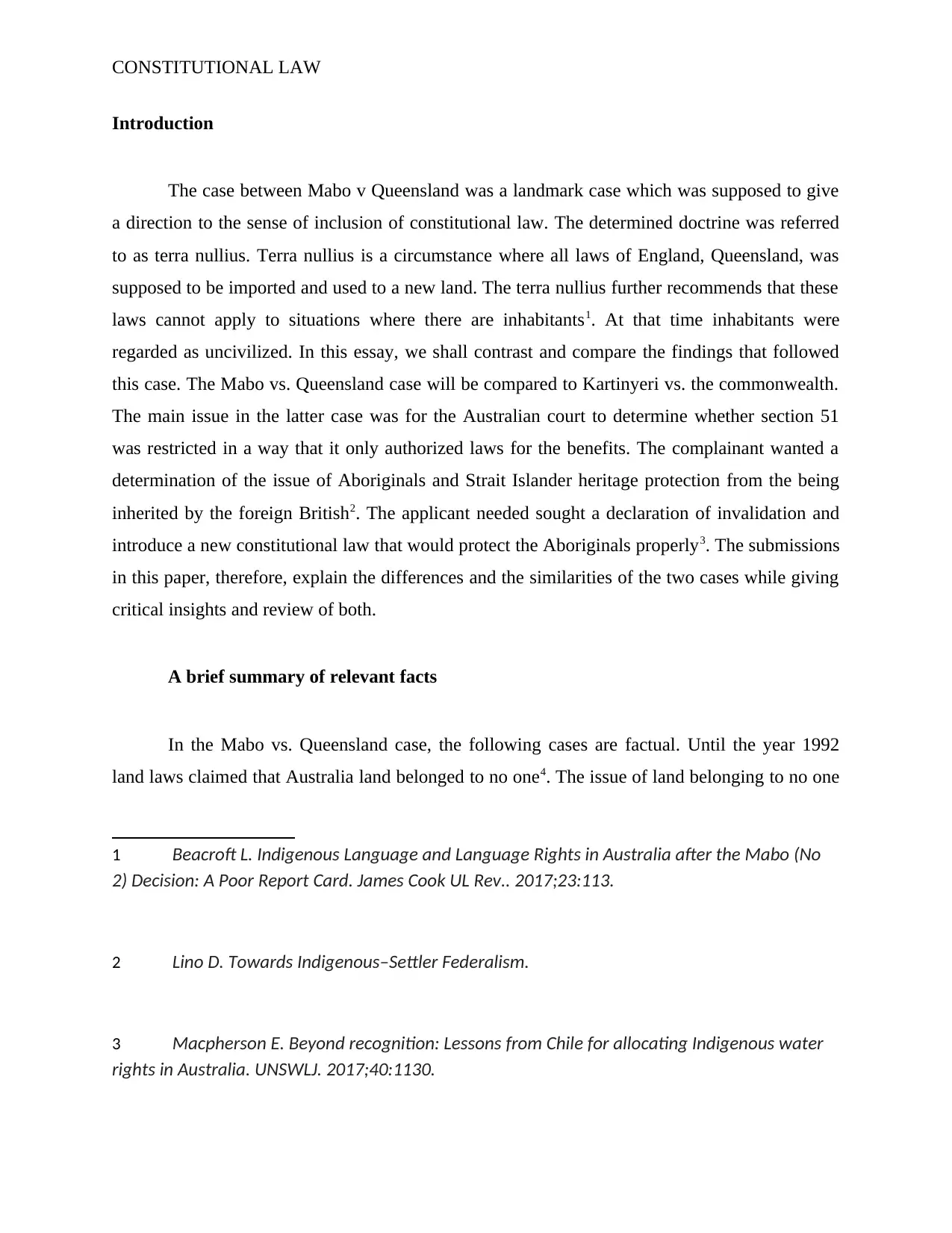
CONSTITUTIONAL LAW
Introduction
The case between Mabo v Queensland was a landmark case which was supposed to give
a direction to the sense of inclusion of constitutional law. The determined doctrine was referred
to as terra nullius. Terra nullius is a circumstance where all laws of England, Queensland, was
supposed to be imported and used to a new land. The terra nullius further recommends that these
laws cannot apply to situations where there are inhabitants1. At that time inhabitants were
regarded as uncivilized. In this essay, we shall contrast and compare the findings that followed
this case. The Mabo vs. Queensland case will be compared to Kartinyeri vs. the commonwealth.
The main issue in the latter case was for the Australian court to determine whether section 51
was restricted in a way that it only authorized laws for the benefits. The complainant wanted a
determination of the issue of Aboriginals and Strait Islander heritage protection from the being
inherited by the foreign British2. The applicant needed sought a declaration of invalidation and
introduce a new constitutional law that would protect the Aboriginals properly3. The submissions
in this paper, therefore, explain the differences and the similarities of the two cases while giving
critical insights and review of both.
A brief summary of relevant facts
In the Mabo vs. Queensland case, the following cases are factual. Until the year 1992
land laws claimed that Australia land belonged to no one4. The issue of land belonging to no one
1 Beacroft L. Indigenous Language and Language Rights in Australia after the Mabo (No
2) Decision: A Poor Report Card. James Cook UL Rev.. 2017;23:113.
2 Lino D. Towards Indigenous–Settler Federalism.
3 Macpherson E. Beyond recognition: Lessons from Chile for allocating Indigenous water
rights in Australia. UNSWLJ. 2017;40:1130.
Introduction
The case between Mabo v Queensland was a landmark case which was supposed to give
a direction to the sense of inclusion of constitutional law. The determined doctrine was referred
to as terra nullius. Terra nullius is a circumstance where all laws of England, Queensland, was
supposed to be imported and used to a new land. The terra nullius further recommends that these
laws cannot apply to situations where there are inhabitants1. At that time inhabitants were
regarded as uncivilized. In this essay, we shall contrast and compare the findings that followed
this case. The Mabo vs. Queensland case will be compared to Kartinyeri vs. the commonwealth.
The main issue in the latter case was for the Australian court to determine whether section 51
was restricted in a way that it only authorized laws for the benefits. The complainant wanted a
determination of the issue of Aboriginals and Strait Islander heritage protection from the being
inherited by the foreign British2. The applicant needed sought a declaration of invalidation and
introduce a new constitutional law that would protect the Aboriginals properly3. The submissions
in this paper, therefore, explain the differences and the similarities of the two cases while giving
critical insights and review of both.
A brief summary of relevant facts
In the Mabo vs. Queensland case, the following cases are factual. Until the year 1992
land laws claimed that Australia land belonged to no one4. The issue of land belonging to no one
1 Beacroft L. Indigenous Language and Language Rights in Australia after the Mabo (No
2) Decision: A Poor Report Card. James Cook UL Rev.. 2017;23:113.
2 Lino D. Towards Indigenous–Settler Federalism.
3 Macpherson E. Beyond recognition: Lessons from Chile for allocating Indigenous water
rights in Australia. UNSWLJ. 2017;40:1130.
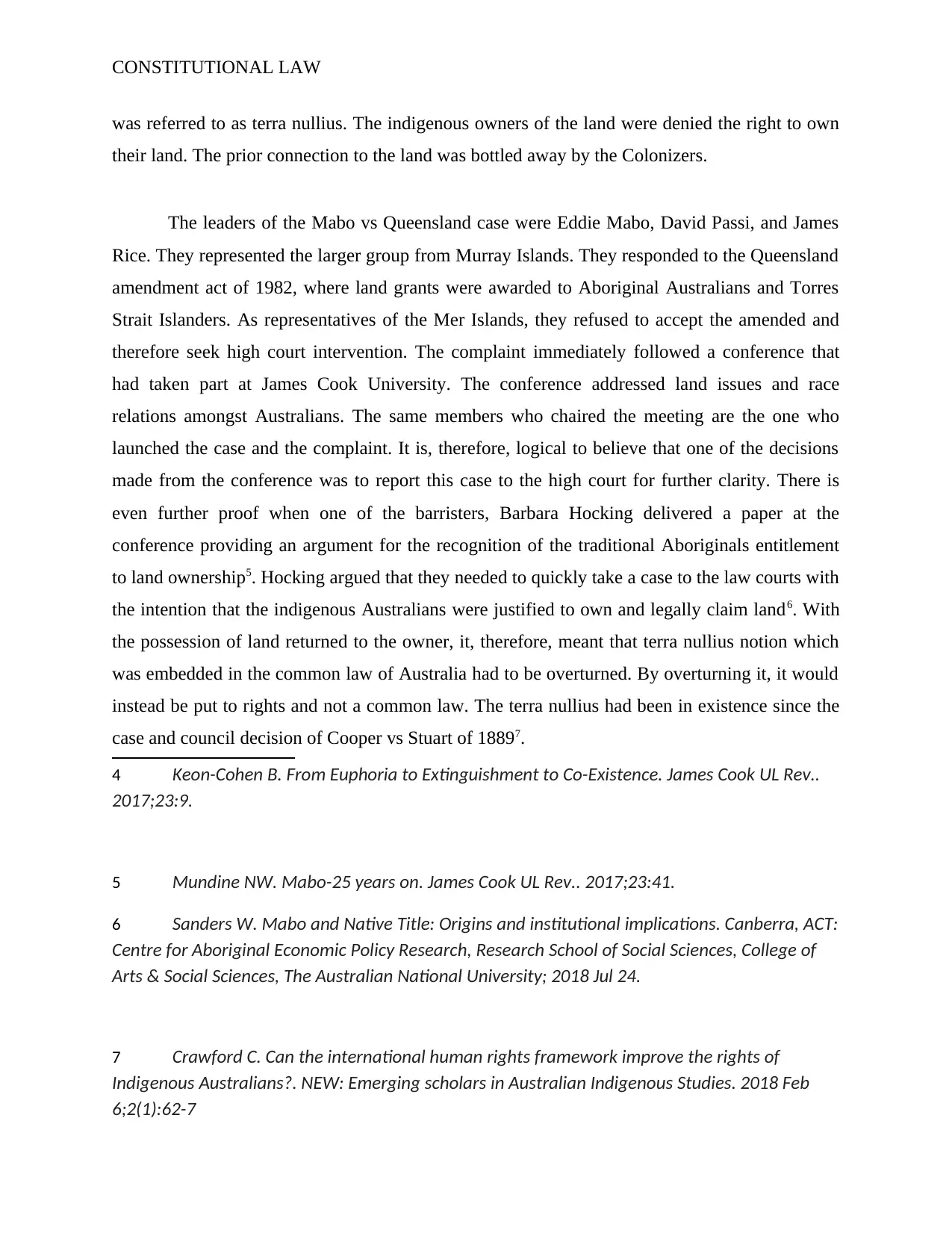
CONSTITUTIONAL LAW
was referred to as terra nullius. The indigenous owners of the land were denied the right to own
their land. The prior connection to the land was bottled away by the Colonizers.
The leaders of the Mabo vs Queensland case were Eddie Mabo, David Passi, and James
Rice. They represented the larger group from Murray Islands. They responded to the Queensland
amendment act of 1982, where land grants were awarded to Aboriginal Australians and Torres
Strait Islanders. As representatives of the Mer Islands, they refused to accept the amended and
therefore seek high court intervention. The complaint immediately followed a conference that
had taken part at James Cook University. The conference addressed land issues and race
relations amongst Australians. The same members who chaired the meeting are the one who
launched the case and the complaint. It is, therefore, logical to believe that one of the decisions
made from the conference was to report this case to the high court for further clarity. There is
even further proof when one of the barristers, Barbara Hocking delivered a paper at the
conference providing an argument for the recognition of the traditional Aboriginals entitlement
to land ownership5. Hocking argued that they needed to quickly take a case to the law courts with
the intention that the indigenous Australians were justified to own and legally claim land6. With
the possession of land returned to the owner, it, therefore, meant that terra nullius notion which
was embedded in the common law of Australia had to be overturned. By overturning it, it would
instead be put to rights and not a common law. The terra nullius had been in existence since the
case and council decision of Cooper vs Stuart of 18897.
4 Keon-Cohen B. From Euphoria to Extinguishment to Co-Existence. James Cook UL Rev..
2017;23:9.
5 Mundine NW. Mabo-25 years on. James Cook UL Rev.. 2017;23:41.
6 Sanders W. Mabo and Native Title: Origins and institutional implications. Canberra, ACT:
Centre for Aboriginal Economic Policy Research, Research School of Social Sciences, College of
Arts & Social Sciences, The Australian National University; 2018 Jul 24.
7 Crawford C. Can the international human rights framework improve the rights of
Indigenous Australians?. NEW: Emerging scholars in Australian Indigenous Studies. 2018 Feb
6;2(1):62-7
was referred to as terra nullius. The indigenous owners of the land were denied the right to own
their land. The prior connection to the land was bottled away by the Colonizers.
The leaders of the Mabo vs Queensland case were Eddie Mabo, David Passi, and James
Rice. They represented the larger group from Murray Islands. They responded to the Queensland
amendment act of 1982, where land grants were awarded to Aboriginal Australians and Torres
Strait Islanders. As representatives of the Mer Islands, they refused to accept the amended and
therefore seek high court intervention. The complaint immediately followed a conference that
had taken part at James Cook University. The conference addressed land issues and race
relations amongst Australians. The same members who chaired the meeting are the one who
launched the case and the complaint. It is, therefore, logical to believe that one of the decisions
made from the conference was to report this case to the high court for further clarity. There is
even further proof when one of the barristers, Barbara Hocking delivered a paper at the
conference providing an argument for the recognition of the traditional Aboriginals entitlement
to land ownership5. Hocking argued that they needed to quickly take a case to the law courts with
the intention that the indigenous Australians were justified to own and legally claim land6. With
the possession of land returned to the owner, it, therefore, meant that terra nullius notion which
was embedded in the common law of Australia had to be overturned. By overturning it, it would
instead be put to rights and not a common law. The terra nullius had been in existence since the
case and council decision of Cooper vs Stuart of 18897.
4 Keon-Cohen B. From Euphoria to Extinguishment to Co-Existence. James Cook UL Rev..
2017;23:9.
5 Mundine NW. Mabo-25 years on. James Cook UL Rev.. 2017;23:41.
6 Sanders W. Mabo and Native Title: Origins and institutional implications. Canberra, ACT:
Centre for Aboriginal Economic Policy Research, Research School of Social Sciences, College of
Arts & Social Sciences, The Australian National University; 2018 Jul 24.
7 Crawford C. Can the international human rights framework improve the rights of
Indigenous Australians?. NEW: Emerging scholars in Australian Indigenous Studies. 2018 Feb
6;2(1):62-7
⊘ This is a preview!⊘
Do you want full access?
Subscribe today to unlock all pages.

Trusted by 1+ million students worldwide
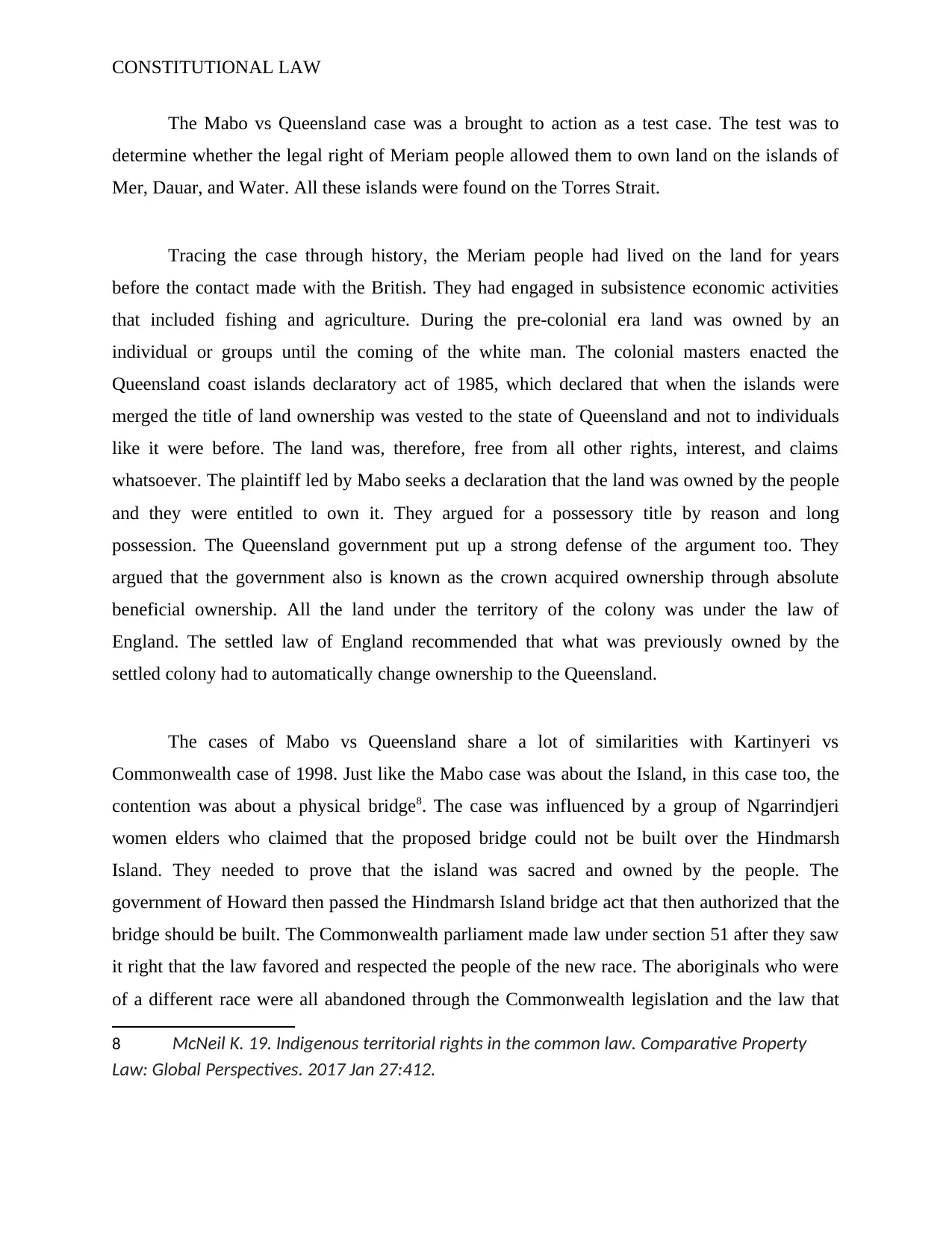
CONSTITUTIONAL LAW
The Mabo vs Queensland case was a brought to action as a test case. The test was to
determine whether the legal right of Meriam people allowed them to own land on the islands of
Mer, Dauar, and Water. All these islands were found on the Torres Strait.
Tracing the case through history, the Meriam people had lived on the land for years
before the contact made with the British. They had engaged in subsistence economic activities
that included fishing and agriculture. During the pre-colonial era land was owned by an
individual or groups until the coming of the white man. The colonial masters enacted the
Queensland coast islands declaratory act of 1985, which declared that when the islands were
merged the title of land ownership was vested to the state of Queensland and not to individuals
like it were before. The land was, therefore, free from all other rights, interest, and claims
whatsoever. The plaintiff led by Mabo seeks a declaration that the land was owned by the people
and they were entitled to own it. They argued for a possessory title by reason and long
possession. The Queensland government put up a strong defense of the argument too. They
argued that the government also is known as the crown acquired ownership through absolute
beneficial ownership. All the land under the territory of the colony was under the law of
England. The settled law of England recommended that what was previously owned by the
settled colony had to automatically change ownership to the Queensland.
The cases of Mabo vs Queensland share a lot of similarities with Kartinyeri vs
Commonwealth case of 1998. Just like the Mabo case was about the Island, in this case too, the
contention was about a physical bridge8. The case was influenced by a group of Ngarrindjeri
women elders who claimed that the proposed bridge could not be built over the Hindmarsh
Island. They needed to prove that the island was sacred and owned by the people. The
government of Howard then passed the Hindmarsh Island bridge act that then authorized that the
bridge should be built. The Commonwealth parliament made law under section 51 after they saw
it right that the law favored and respected the people of the new race. The aboriginals who were
of a different race were all abandoned through the Commonwealth legislation and the law that
8 McNeil K. 19. Indigenous territorial rights in the common law. Comparative Property
Law: Global Perspectives. 2017 Jan 27:412.
The Mabo vs Queensland case was a brought to action as a test case. The test was to
determine whether the legal right of Meriam people allowed them to own land on the islands of
Mer, Dauar, and Water. All these islands were found on the Torres Strait.
Tracing the case through history, the Meriam people had lived on the land for years
before the contact made with the British. They had engaged in subsistence economic activities
that included fishing and agriculture. During the pre-colonial era land was owned by an
individual or groups until the coming of the white man. The colonial masters enacted the
Queensland coast islands declaratory act of 1985, which declared that when the islands were
merged the title of land ownership was vested to the state of Queensland and not to individuals
like it were before. The land was, therefore, free from all other rights, interest, and claims
whatsoever. The plaintiff led by Mabo seeks a declaration that the land was owned by the people
and they were entitled to own it. They argued for a possessory title by reason and long
possession. The Queensland government put up a strong defense of the argument too. They
argued that the government also is known as the crown acquired ownership through absolute
beneficial ownership. All the land under the territory of the colony was under the law of
England. The settled law of England recommended that what was previously owned by the
settled colony had to automatically change ownership to the Queensland.
The cases of Mabo vs Queensland share a lot of similarities with Kartinyeri vs
Commonwealth case of 1998. Just like the Mabo case was about the Island, in this case too, the
contention was about a physical bridge8. The case was influenced by a group of Ngarrindjeri
women elders who claimed that the proposed bridge could not be built over the Hindmarsh
Island. They needed to prove that the island was sacred and owned by the people. The
government of Howard then passed the Hindmarsh Island bridge act that then authorized that the
bridge should be built. The Commonwealth parliament made law under section 51 after they saw
it right that the law favored and respected the people of the new race. The aboriginals who were
of a different race were all abandoned through the Commonwealth legislation and the law that
8 McNeil K. 19. Indigenous territorial rights in the common law. Comparative Property
Law: Global Perspectives. 2017 Jan 27:412.
Paraphrase This Document
Need a fresh take? Get an instant paraphrase of this document with our AI Paraphraser
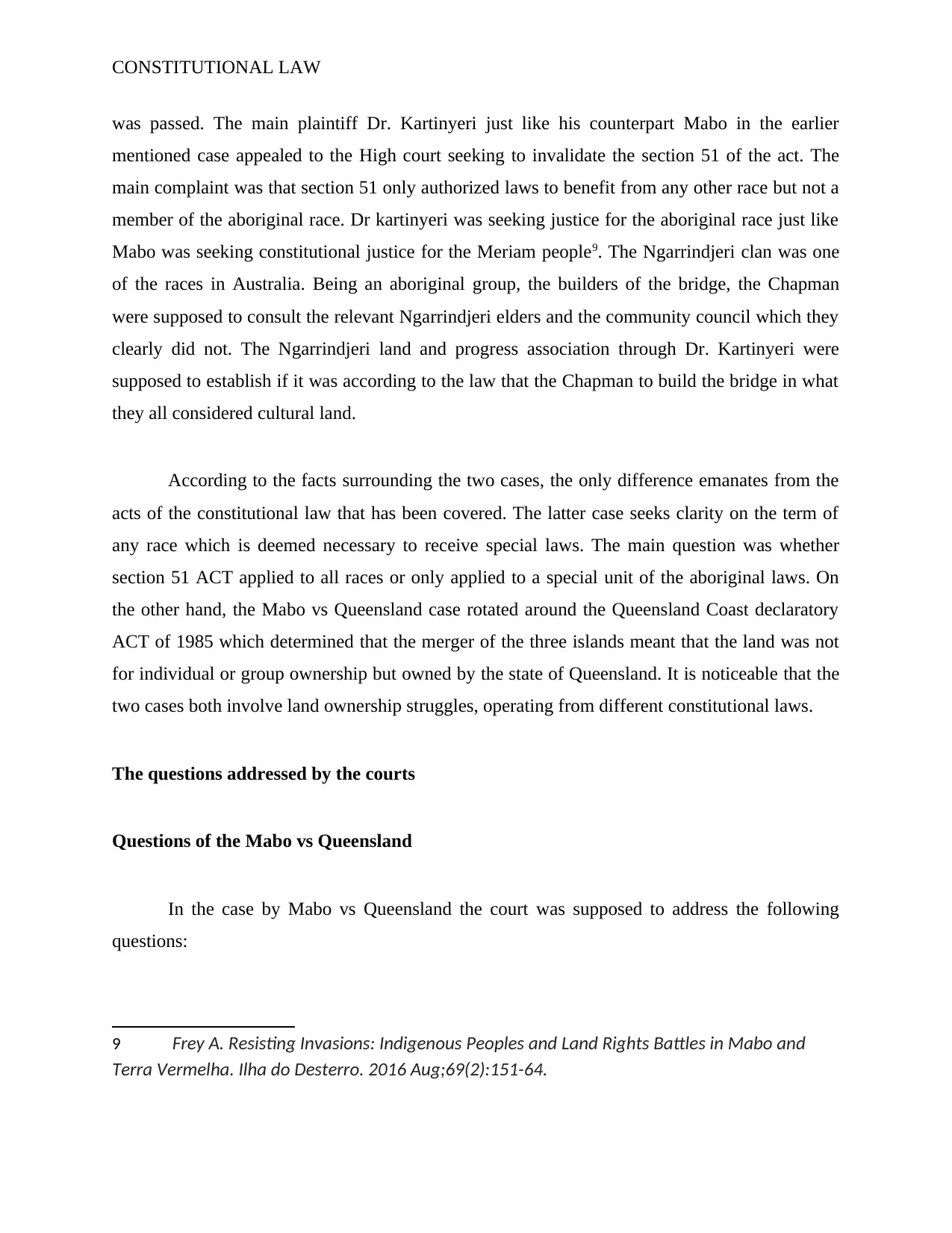
CONSTITUTIONAL LAW
was passed. The main plaintiff Dr. Kartinyeri just like his counterpart Mabo in the earlier
mentioned case appealed to the High court seeking to invalidate the section 51 of the act. The
main complaint was that section 51 only authorized laws to benefit from any other race but not a
member of the aboriginal race. Dr kartinyeri was seeking justice for the aboriginal race just like
Mabo was seeking constitutional justice for the Meriam people9. The Ngarrindjeri clan was one
of the races in Australia. Being an aboriginal group, the builders of the bridge, the Chapman
were supposed to consult the relevant Ngarrindjeri elders and the community council which they
clearly did not. The Ngarrindjeri land and progress association through Dr. Kartinyeri were
supposed to establish if it was according to the law that the Chapman to build the bridge in what
they all considered cultural land.
According to the facts surrounding the two cases, the only difference emanates from the
acts of the constitutional law that has been covered. The latter case seeks clarity on the term of
any race which is deemed necessary to receive special laws. The main question was whether
section 51 ACT applied to all races or only applied to a special unit of the aboriginal laws. On
the other hand, the Mabo vs Queensland case rotated around the Queensland Coast declaratory
ACT of 1985 which determined that the merger of the three islands meant that the land was not
for individual or group ownership but owned by the state of Queensland. It is noticeable that the
two cases both involve land ownership struggles, operating from different constitutional laws.
The questions addressed by the courts
Questions of the Mabo vs Queensland
In the case by Mabo vs Queensland the court was supposed to address the following
questions:
9 Frey A. Resisting Invasions: Indigenous Peoples and Land Rights Battles in Mabo and
Terra Vermelha. Ilha do Desterro. 2016 Aug;69(2):151-64.
was passed. The main plaintiff Dr. Kartinyeri just like his counterpart Mabo in the earlier
mentioned case appealed to the High court seeking to invalidate the section 51 of the act. The
main complaint was that section 51 only authorized laws to benefit from any other race but not a
member of the aboriginal race. Dr kartinyeri was seeking justice for the aboriginal race just like
Mabo was seeking constitutional justice for the Meriam people9. The Ngarrindjeri clan was one
of the races in Australia. Being an aboriginal group, the builders of the bridge, the Chapman
were supposed to consult the relevant Ngarrindjeri elders and the community council which they
clearly did not. The Ngarrindjeri land and progress association through Dr. Kartinyeri were
supposed to establish if it was according to the law that the Chapman to build the bridge in what
they all considered cultural land.
According to the facts surrounding the two cases, the only difference emanates from the
acts of the constitutional law that has been covered. The latter case seeks clarity on the term of
any race which is deemed necessary to receive special laws. The main question was whether
section 51 ACT applied to all races or only applied to a special unit of the aboriginal laws. On
the other hand, the Mabo vs Queensland case rotated around the Queensland Coast declaratory
ACT of 1985 which determined that the merger of the three islands meant that the land was not
for individual or group ownership but owned by the state of Queensland. It is noticeable that the
two cases both involve land ownership struggles, operating from different constitutional laws.
The questions addressed by the courts
Questions of the Mabo vs Queensland
In the case by Mabo vs Queensland the court was supposed to address the following
questions:
9 Frey A. Resisting Invasions: Indigenous Peoples and Land Rights Battles in Mabo and
Terra Vermelha. Ilha do Desterro. 2016 Aug;69(2):151-64.
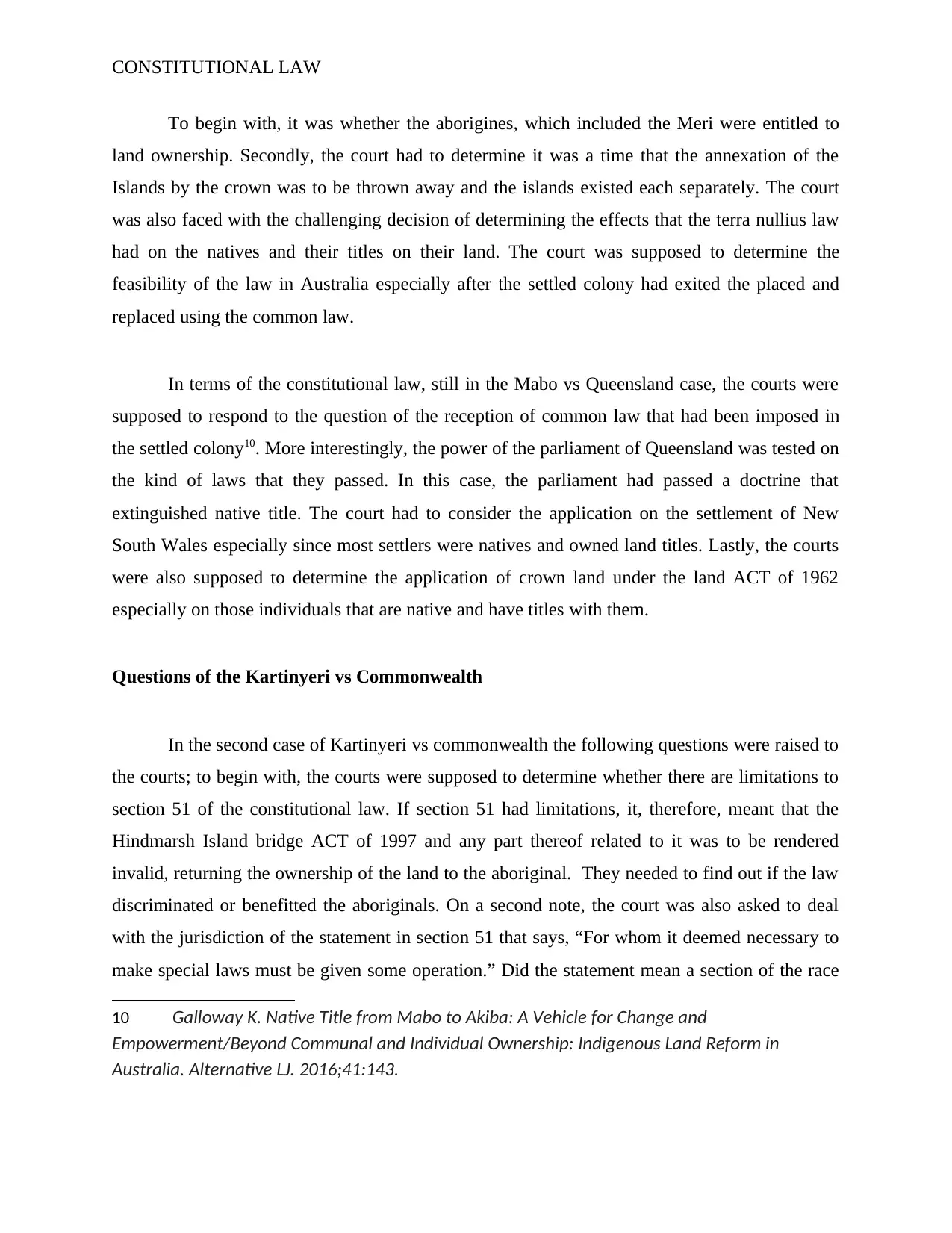
CONSTITUTIONAL LAW
To begin with, it was whether the aborigines, which included the Meri were entitled to
land ownership. Secondly, the court had to determine it was a time that the annexation of the
Islands by the crown was to be thrown away and the islands existed each separately. The court
was also faced with the challenging decision of determining the effects that the terra nullius law
had on the natives and their titles on their land. The court was supposed to determine the
feasibility of the law in Australia especially after the settled colony had exited the placed and
replaced using the common law.
In terms of the constitutional law, still in the Mabo vs Queensland case, the courts were
supposed to respond to the question of the reception of common law that had been imposed in
the settled colony10. More interestingly, the power of the parliament of Queensland was tested on
the kind of laws that they passed. In this case, the parliament had passed a doctrine that
extinguished native title. The court had to consider the application on the settlement of New
South Wales especially since most settlers were natives and owned land titles. Lastly, the courts
were also supposed to determine the application of crown land under the land ACT of 1962
especially on those individuals that are native and have titles with them.
Questions of the Kartinyeri vs Commonwealth
In the second case of Kartinyeri vs commonwealth the following questions were raised to
the courts; to begin with, the courts were supposed to determine whether there are limitations to
section 51 of the constitutional law. If section 51 had limitations, it, therefore, meant that the
Hindmarsh Island bridge ACT of 1997 and any part thereof related to it was to be rendered
invalid, returning the ownership of the land to the aboriginal. They needed to find out if the law
discriminated or benefitted the aboriginals. On a second note, the court was also asked to deal
with the jurisdiction of the statement in section 51 that says, “For whom it deemed necessary to
make special laws must be given some operation.” Did the statement mean a section of the race
10 Galloway K. Native Title from Mabo to Akiba: A Vehicle for Change and
Empowerment/Beyond Communal and Individual Ownership: Indigenous Land Reform in
Australia. Alternative LJ. 2016;41:143.
To begin with, it was whether the aborigines, which included the Meri were entitled to
land ownership. Secondly, the court had to determine it was a time that the annexation of the
Islands by the crown was to be thrown away and the islands existed each separately. The court
was also faced with the challenging decision of determining the effects that the terra nullius law
had on the natives and their titles on their land. The court was supposed to determine the
feasibility of the law in Australia especially after the settled colony had exited the placed and
replaced using the common law.
In terms of the constitutional law, still in the Mabo vs Queensland case, the courts were
supposed to respond to the question of the reception of common law that had been imposed in
the settled colony10. More interestingly, the power of the parliament of Queensland was tested on
the kind of laws that they passed. In this case, the parliament had passed a doctrine that
extinguished native title. The court had to consider the application on the settlement of New
South Wales especially since most settlers were natives and owned land titles. Lastly, the courts
were also supposed to determine the application of crown land under the land ACT of 1962
especially on those individuals that are native and have titles with them.
Questions of the Kartinyeri vs Commonwealth
In the second case of Kartinyeri vs commonwealth the following questions were raised to
the courts; to begin with, the courts were supposed to determine whether there are limitations to
section 51 of the constitutional law. If section 51 had limitations, it, therefore, meant that the
Hindmarsh Island bridge ACT of 1997 and any part thereof related to it was to be rendered
invalid, returning the ownership of the land to the aboriginal. They needed to find out if the law
discriminated or benefitted the aboriginals. On a second note, the court was also asked to deal
with the jurisdiction of the statement in section 51 that says, “For whom it deemed necessary to
make special laws must be given some operation.” Did the statement mean a section of the race
10 Galloway K. Native Title from Mabo to Akiba: A Vehicle for Change and
Empowerment/Beyond Communal and Individual Ownership: Indigenous Land Reform in
Australia. Alternative LJ. 2016;41:143.
⊘ This is a preview!⊘
Do you want full access?
Subscribe today to unlock all pages.

Trusted by 1+ million students worldwide
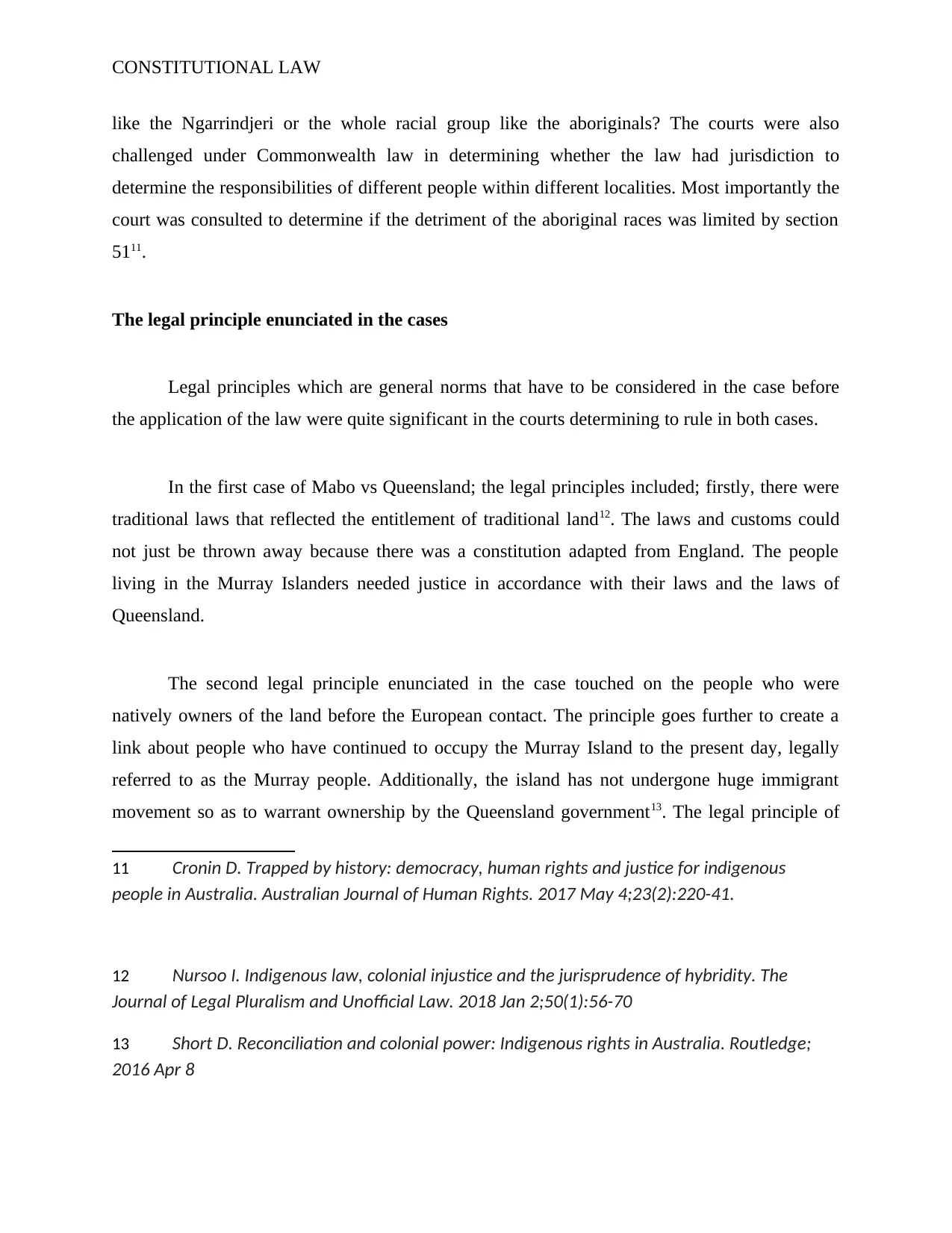
CONSTITUTIONAL LAW
like the Ngarrindjeri or the whole racial group like the aboriginals? The courts were also
challenged under Commonwealth law in determining whether the law had jurisdiction to
determine the responsibilities of different people within different localities. Most importantly the
court was consulted to determine if the detriment of the aboriginal races was limited by section
5111.
The legal principle enunciated in the cases
Legal principles which are general norms that have to be considered in the case before
the application of the law were quite significant in the courts determining to rule in both cases.
In the first case of Mabo vs Queensland; the legal principles included; firstly, there were
traditional laws that reflected the entitlement of traditional land12. The laws and customs could
not just be thrown away because there was a constitution adapted from England. The people
living in the Murray Islanders needed justice in accordance with their laws and the laws of
Queensland.
The second legal principle enunciated in the case touched on the people who were
natively owners of the land before the European contact. The principle goes further to create a
link about people who have continued to occupy the Murray Island to the present day, legally
referred to as the Murray people. Additionally, the island has not undergone huge immigrant
movement so as to warrant ownership by the Queensland government13. The legal principle of
11 Cronin D. Trapped by history: democracy, human rights and justice for indigenous
people in Australia. Australian Journal of Human Rights. 2017 May 4;23(2):220-41.
12 Nursoo I. Indigenous law, colonial injustice and the jurisprudence of hybridity. The
Journal of Legal Pluralism and Unofficial Law. 2018 Jan 2;50(1):56-70
13 Short D. Reconciliation and colonial power: Indigenous rights in Australia. Routledge;
2016 Apr 8
like the Ngarrindjeri or the whole racial group like the aboriginals? The courts were also
challenged under Commonwealth law in determining whether the law had jurisdiction to
determine the responsibilities of different people within different localities. Most importantly the
court was consulted to determine if the detriment of the aboriginal races was limited by section
5111.
The legal principle enunciated in the cases
Legal principles which are general norms that have to be considered in the case before
the application of the law were quite significant in the courts determining to rule in both cases.
In the first case of Mabo vs Queensland; the legal principles included; firstly, there were
traditional laws that reflected the entitlement of traditional land12. The laws and customs could
not just be thrown away because there was a constitution adapted from England. The people
living in the Murray Islanders needed justice in accordance with their laws and the laws of
Queensland.
The second legal principle enunciated in the case touched on the people who were
natively owners of the land before the European contact. The principle goes further to create a
link about people who have continued to occupy the Murray Island to the present day, legally
referred to as the Murray people. Additionally, the island has not undergone huge immigrant
movement so as to warrant ownership by the Queensland government13. The legal principle of
11 Cronin D. Trapped by history: democracy, human rights and justice for indigenous
people in Australia. Australian Journal of Human Rights. 2017 May 4;23(2):220-41.
12 Nursoo I. Indigenous law, colonial injustice and the jurisprudence of hybridity. The
Journal of Legal Pluralism and Unofficial Law. 2018 Jan 2;50(1):56-70
13 Short D. Reconciliation and colonial power: Indigenous rights in Australia. Routledge;
2016 Apr 8
Paraphrase This Document
Need a fresh take? Get an instant paraphrase of this document with our AI Paraphraser
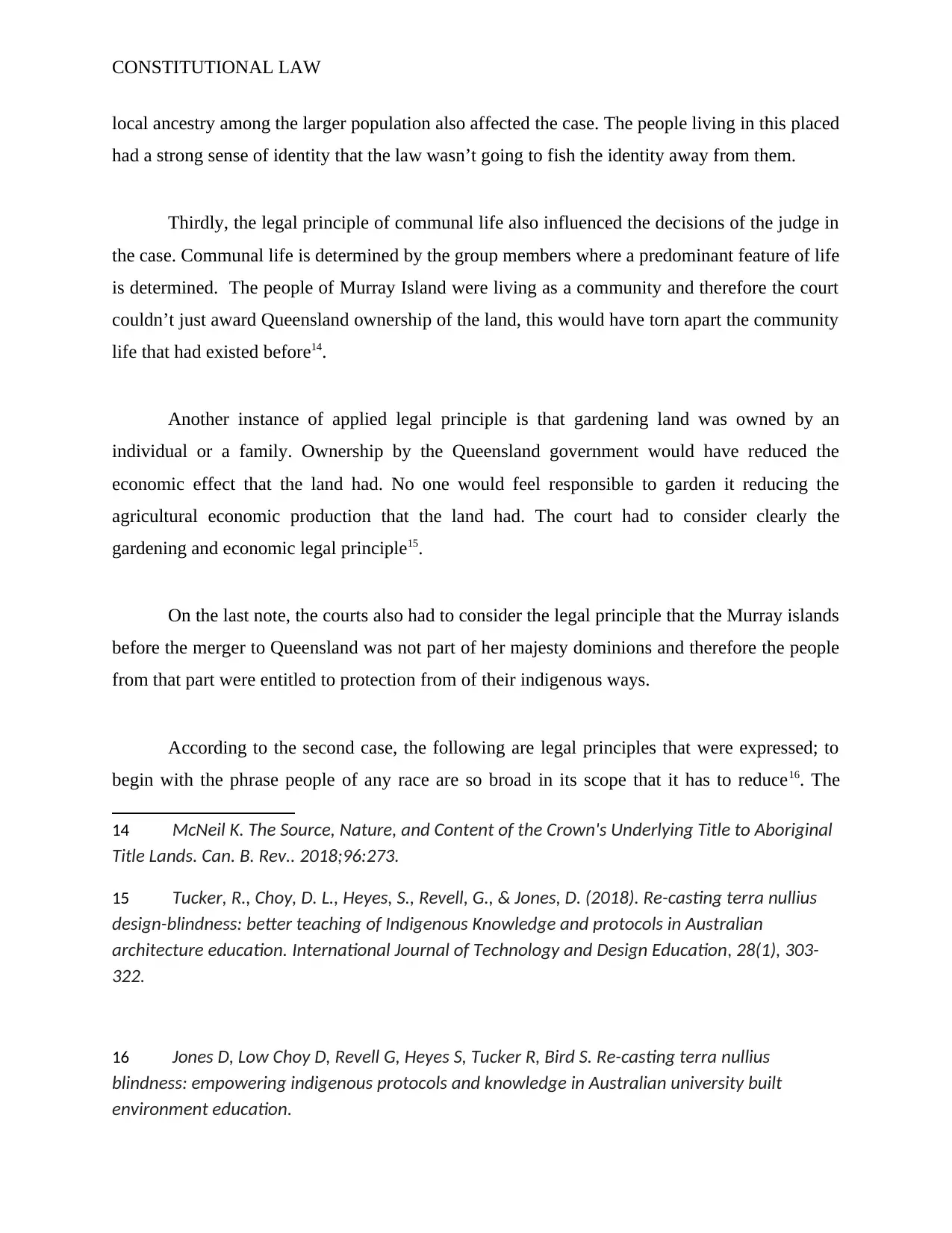
CONSTITUTIONAL LAW
local ancestry among the larger population also affected the case. The people living in this placed
had a strong sense of identity that the law wasn’t going to fish the identity away from them.
Thirdly, the legal principle of communal life also influenced the decisions of the judge in
the case. Communal life is determined by the group members where a predominant feature of life
is determined. The people of Murray Island were living as a community and therefore the court
couldn’t just award Queensland ownership of the land, this would have torn apart the community
life that had existed before14.
Another instance of applied legal principle is that gardening land was owned by an
individual or a family. Ownership by the Queensland government would have reduced the
economic effect that the land had. No one would feel responsible to garden it reducing the
agricultural economic production that the land had. The court had to consider clearly the
gardening and economic legal principle15.
On the last note, the courts also had to consider the legal principle that the Murray islands
before the merger to Queensland was not part of her majesty dominions and therefore the people
from that part were entitled to protection from of their indigenous ways.
According to the second case, the following are legal principles that were expressed; to
begin with the phrase people of any race are so broad in its scope that it has to reduce16. The
14 McNeil K. The Source, Nature, and Content of the Crown's Underlying Title to Aboriginal
Title Lands. Can. B. Rev.. 2018;96:273.
15 Tucker, R., Choy, D. L., Heyes, S., Revell, G., & Jones, D. (2018). Re-casting terra nullius
design-blindness: better teaching of Indigenous Knowledge and protocols in Australian
architecture education. International Journal of Technology and Design Education, 28(1), 303-
322.
16 Jones D, Low Choy D, Revell G, Heyes S, Tucker R, Bird S. Re-casting terra nullius
blindness: empowering indigenous protocols and knowledge in Australian university built
environment education.
local ancestry among the larger population also affected the case. The people living in this placed
had a strong sense of identity that the law wasn’t going to fish the identity away from them.
Thirdly, the legal principle of communal life also influenced the decisions of the judge in
the case. Communal life is determined by the group members where a predominant feature of life
is determined. The people of Murray Island were living as a community and therefore the court
couldn’t just award Queensland ownership of the land, this would have torn apart the community
life that had existed before14.
Another instance of applied legal principle is that gardening land was owned by an
individual or a family. Ownership by the Queensland government would have reduced the
economic effect that the land had. No one would feel responsible to garden it reducing the
agricultural economic production that the land had. The court had to consider clearly the
gardening and economic legal principle15.
On the last note, the courts also had to consider the legal principle that the Murray islands
before the merger to Queensland was not part of her majesty dominions and therefore the people
from that part were entitled to protection from of their indigenous ways.
According to the second case, the following are legal principles that were expressed; to
begin with the phrase people of any race are so broad in its scope that it has to reduce16. The
14 McNeil K. The Source, Nature, and Content of the Crown's Underlying Title to Aboriginal
Title Lands. Can. B. Rev.. 2018;96:273.
15 Tucker, R., Choy, D. L., Heyes, S., Revell, G., & Jones, D. (2018). Re-casting terra nullius
design-blindness: better teaching of Indigenous Knowledge and protocols in Australian
architecture education. International Journal of Technology and Design Education, 28(1), 303-
322.
16 Jones D, Low Choy D, Revell G, Heyes S, Tucker R, Bird S. Re-casting terra nullius
blindness: empowering indigenous protocols and knowledge in Australian university built
environment education.
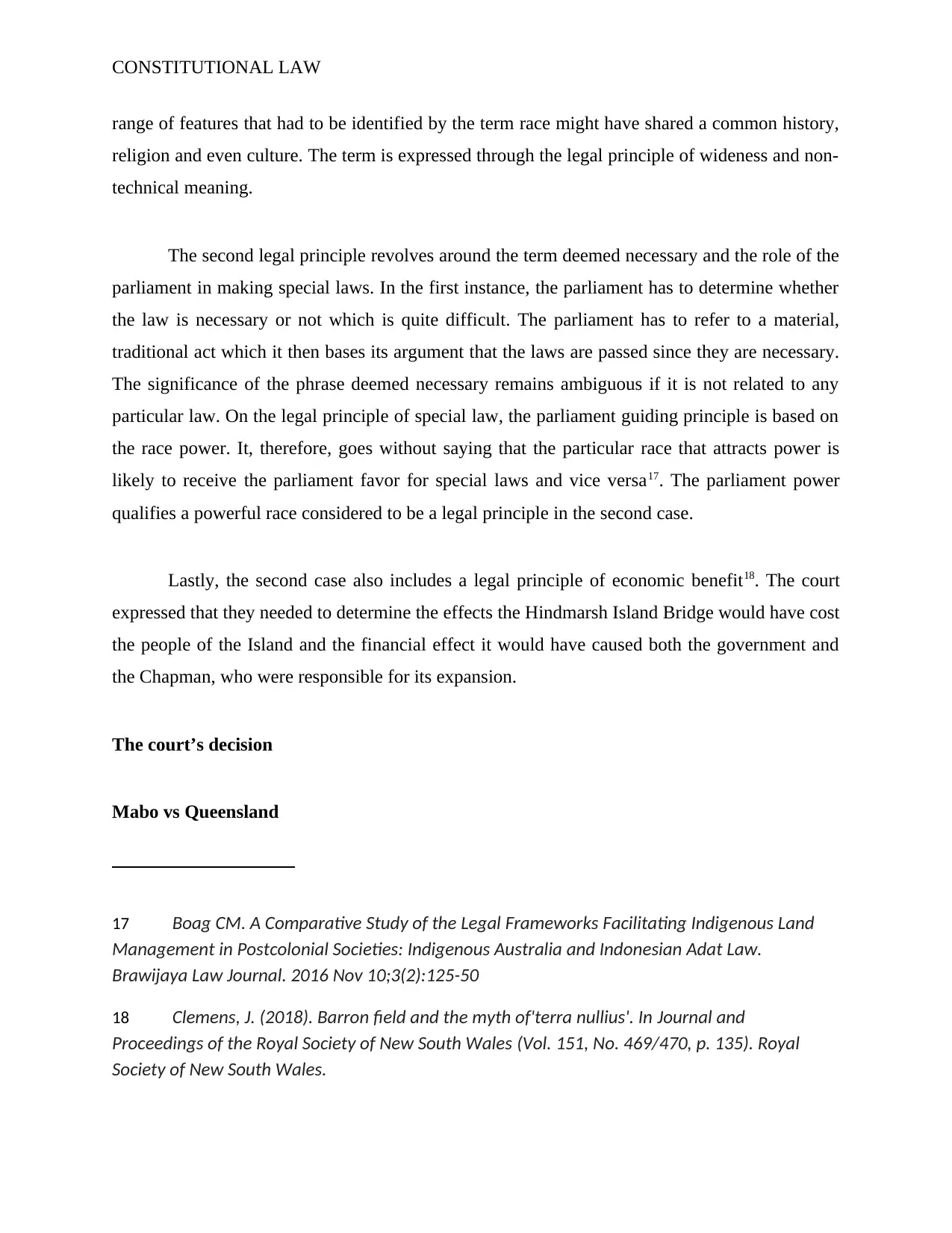
CONSTITUTIONAL LAW
range of features that had to be identified by the term race might have shared a common history,
religion and even culture. The term is expressed through the legal principle of wideness and non-
technical meaning.
The second legal principle revolves around the term deemed necessary and the role of the
parliament in making special laws. In the first instance, the parliament has to determine whether
the law is necessary or not which is quite difficult. The parliament has to refer to a material,
traditional act which it then bases its argument that the laws are passed since they are necessary.
The significance of the phrase deemed necessary remains ambiguous if it is not related to any
particular law. On the legal principle of special law, the parliament guiding principle is based on
the race power. It, therefore, goes without saying that the particular race that attracts power is
likely to receive the parliament favor for special laws and vice versa17. The parliament power
qualifies a powerful race considered to be a legal principle in the second case.
Lastly, the second case also includes a legal principle of economic benefit18. The court
expressed that they needed to determine the effects the Hindmarsh Island Bridge would have cost
the people of the Island and the financial effect it would have caused both the government and
the Chapman, who were responsible for its expansion.
The court’s decision
Mabo vs Queensland
17 Boag CM. A Comparative Study of the Legal Frameworks Facilitating Indigenous Land
Management in Postcolonial Societies: Indigenous Australia and Indonesian Adat Law.
Brawijaya Law Journal. 2016 Nov 10;3(2):125-50
18 Clemens, J. (2018). Barron field and the myth of'terra nullius'. In Journal and
Proceedings of the Royal Society of New South Wales (Vol. 151, No. 469/470, p. 135). Royal
Society of New South Wales.
range of features that had to be identified by the term race might have shared a common history,
religion and even culture. The term is expressed through the legal principle of wideness and non-
technical meaning.
The second legal principle revolves around the term deemed necessary and the role of the
parliament in making special laws. In the first instance, the parliament has to determine whether
the law is necessary or not which is quite difficult. The parliament has to refer to a material,
traditional act which it then bases its argument that the laws are passed since they are necessary.
The significance of the phrase deemed necessary remains ambiguous if it is not related to any
particular law. On the legal principle of special law, the parliament guiding principle is based on
the race power. It, therefore, goes without saying that the particular race that attracts power is
likely to receive the parliament favor for special laws and vice versa17. The parliament power
qualifies a powerful race considered to be a legal principle in the second case.
Lastly, the second case also includes a legal principle of economic benefit18. The court
expressed that they needed to determine the effects the Hindmarsh Island Bridge would have cost
the people of the Island and the financial effect it would have caused both the government and
the Chapman, who were responsible for its expansion.
The court’s decision
Mabo vs Queensland
17 Boag CM. A Comparative Study of the Legal Frameworks Facilitating Indigenous Land
Management in Postcolonial Societies: Indigenous Australia and Indonesian Adat Law.
Brawijaya Law Journal. 2016 Nov 10;3(2):125-50
18 Clemens, J. (2018). Barron field and the myth of'terra nullius'. In Journal and
Proceedings of the Royal Society of New South Wales (Vol. 151, No. 469/470, p. 135). Royal
Society of New South Wales.
⊘ This is a preview!⊘
Do you want full access?
Subscribe today to unlock all pages.

Trusted by 1+ million students worldwide
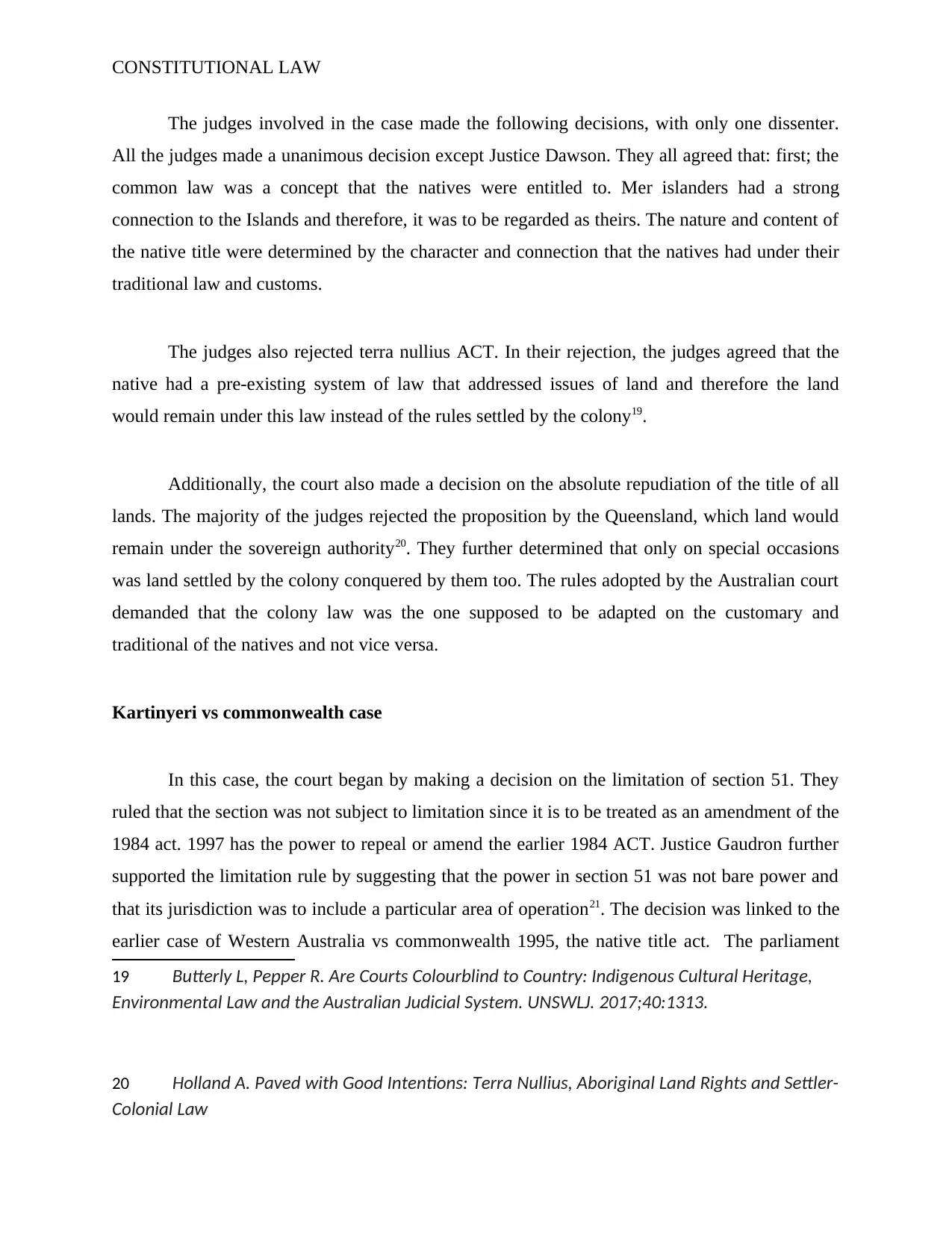
CONSTITUTIONAL LAW
The judges involved in the case made the following decisions, with only one dissenter.
All the judges made a unanimous decision except Justice Dawson. They all agreed that: first; the
common law was a concept that the natives were entitled to. Mer islanders had a strong
connection to the Islands and therefore, it was to be regarded as theirs. The nature and content of
the native title were determined by the character and connection that the natives had under their
traditional law and customs.
The judges also rejected terra nullius ACT. In their rejection, the judges agreed that the
native had a pre-existing system of law that addressed issues of land and therefore the land
would remain under this law instead of the rules settled by the colony19.
Additionally, the court also made a decision on the absolute repudiation of the title of all
lands. The majority of the judges rejected the proposition by the Queensland, which land would
remain under the sovereign authority20. They further determined that only on special occasions
was land settled by the colony conquered by them too. The rules adopted by the Australian court
demanded that the colony law was the one supposed to be adapted on the customary and
traditional of the natives and not vice versa.
Kartinyeri vs commonwealth case
In this case, the court began by making a decision on the limitation of section 51. They
ruled that the section was not subject to limitation since it is to be treated as an amendment of the
1984 act. 1997 has the power to repeal or amend the earlier 1984 ACT. Justice Gaudron further
supported the limitation rule by suggesting that the power in section 51 was not bare power and
that its jurisdiction was to include a particular area of operation21. The decision was linked to the
earlier case of Western Australia vs commonwealth 1995, the native title act. The parliament
19 Butterly L, Pepper R. Are Courts Colourblind to Country: Indigenous Cultural Heritage,
Environmental Law and the Australian Judicial System. UNSWLJ. 2017;40:1313.
20 Holland A. Paved with Good Intentions: Terra Nullius, Aboriginal Land Rights and Settler-
Colonial Law
The judges involved in the case made the following decisions, with only one dissenter.
All the judges made a unanimous decision except Justice Dawson. They all agreed that: first; the
common law was a concept that the natives were entitled to. Mer islanders had a strong
connection to the Islands and therefore, it was to be regarded as theirs. The nature and content of
the native title were determined by the character and connection that the natives had under their
traditional law and customs.
The judges also rejected terra nullius ACT. In their rejection, the judges agreed that the
native had a pre-existing system of law that addressed issues of land and therefore the land
would remain under this law instead of the rules settled by the colony19.
Additionally, the court also made a decision on the absolute repudiation of the title of all
lands. The majority of the judges rejected the proposition by the Queensland, which land would
remain under the sovereign authority20. They further determined that only on special occasions
was land settled by the colony conquered by them too. The rules adopted by the Australian court
demanded that the colony law was the one supposed to be adapted on the customary and
traditional of the natives and not vice versa.
Kartinyeri vs commonwealth case
In this case, the court began by making a decision on the limitation of section 51. They
ruled that the section was not subject to limitation since it is to be treated as an amendment of the
1984 act. 1997 has the power to repeal or amend the earlier 1984 ACT. Justice Gaudron further
supported the limitation rule by suggesting that the power in section 51 was not bare power and
that its jurisdiction was to include a particular area of operation21. The decision was linked to the
earlier case of Western Australia vs commonwealth 1995, the native title act. The parliament
19 Butterly L, Pepper R. Are Courts Colourblind to Country: Indigenous Cultural Heritage,
Environmental Law and the Australian Judicial System. UNSWLJ. 2017;40:1313.
20 Holland A. Paved with Good Intentions: Terra Nullius, Aboriginal Land Rights and Settler-
Colonial Law
Paraphrase This Document
Need a fresh take? Get an instant paraphrase of this document with our AI Paraphraser
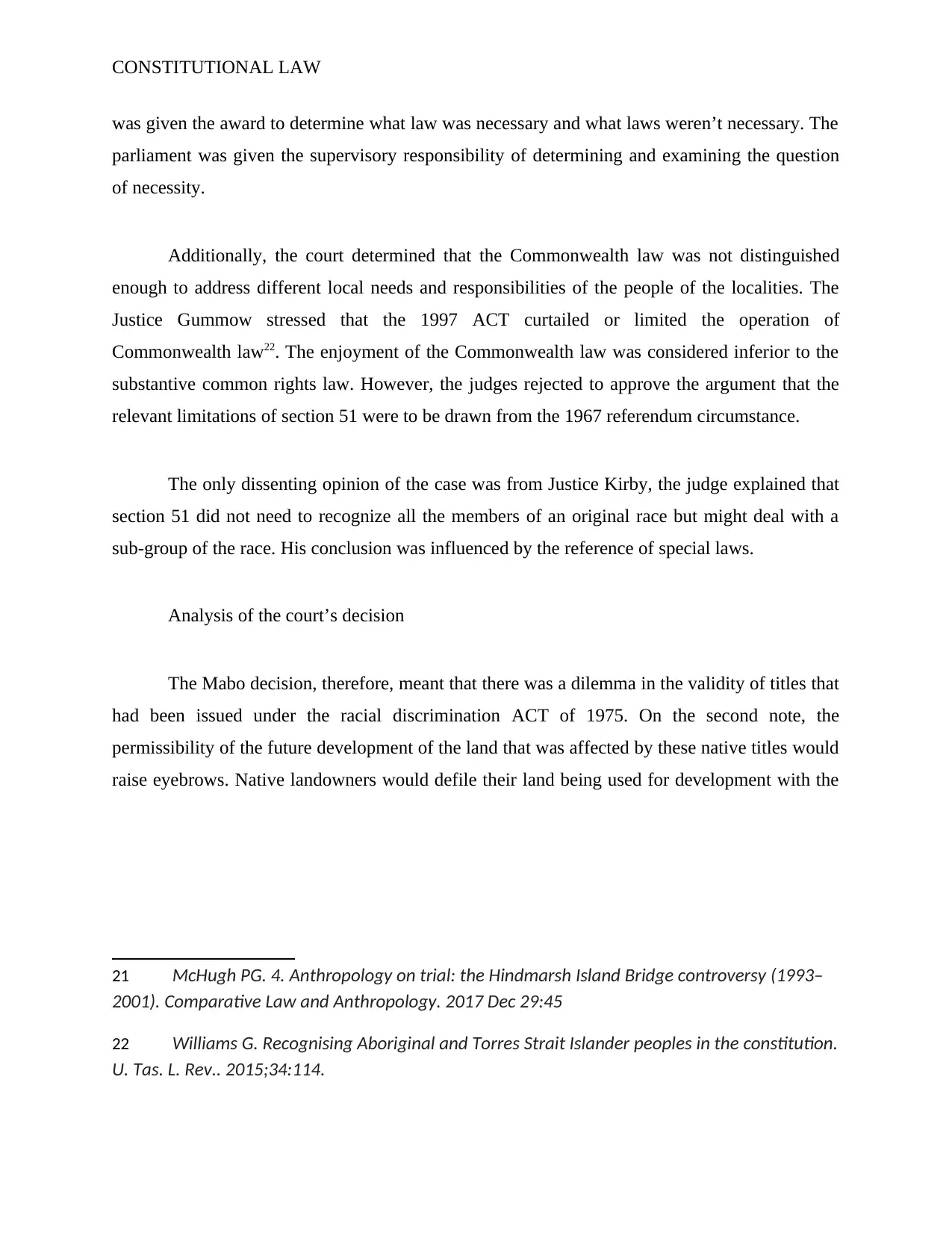
CONSTITUTIONAL LAW
was given the award to determine what law was necessary and what laws weren’t necessary. The
parliament was given the supervisory responsibility of determining and examining the question
of necessity.
Additionally, the court determined that the Commonwealth law was not distinguished
enough to address different local needs and responsibilities of the people of the localities. The
Justice Gummow stressed that the 1997 ACT curtailed or limited the operation of
Commonwealth law22. The enjoyment of the Commonwealth law was considered inferior to the
substantive common rights law. However, the judges rejected to approve the argument that the
relevant limitations of section 51 were to be drawn from the 1967 referendum circumstance.
The only dissenting opinion of the case was from Justice Kirby, the judge explained that
section 51 did not need to recognize all the members of an original race but might deal with a
sub-group of the race. His conclusion was influenced by the reference of special laws.
Analysis of the court’s decision
The Mabo decision, therefore, meant that there was a dilemma in the validity of titles that
had been issued under the racial discrimination ACT of 1975. On the second note, the
permissibility of the future development of the land that was affected by these native titles would
raise eyebrows. Native landowners would defile their land being used for development with the
21 McHugh PG. 4. Anthropology on trial: the Hindmarsh Island Bridge controversy (1993–
2001). Comparative Law and Anthropology. 2017 Dec 29:45
22 Williams G. Recognising Aboriginal and Torres Strait Islander peoples in the constitution.
U. Tas. L. Rev.. 2015;34:114.
was given the award to determine what law was necessary and what laws weren’t necessary. The
parliament was given the supervisory responsibility of determining and examining the question
of necessity.
Additionally, the court determined that the Commonwealth law was not distinguished
enough to address different local needs and responsibilities of the people of the localities. The
Justice Gummow stressed that the 1997 ACT curtailed or limited the operation of
Commonwealth law22. The enjoyment of the Commonwealth law was considered inferior to the
substantive common rights law. However, the judges rejected to approve the argument that the
relevant limitations of section 51 were to be drawn from the 1967 referendum circumstance.
The only dissenting opinion of the case was from Justice Kirby, the judge explained that
section 51 did not need to recognize all the members of an original race but might deal with a
sub-group of the race. His conclusion was influenced by the reference of special laws.
Analysis of the court’s decision
The Mabo decision, therefore, meant that there was a dilemma in the validity of titles that
had been issued under the racial discrimination ACT of 1975. On the second note, the
permissibility of the future development of the land that was affected by these native titles would
raise eyebrows. Native landowners would defile their land being used for development with the
21 McHugh PG. 4. Anthropology on trial: the Hindmarsh Island Bridge controversy (1993–
2001). Comparative Law and Anthropology. 2017 Dec 29:45
22 Williams G. Recognising Aboriginal and Torres Strait Islander peoples in the constitution.
U. Tas. L. Rev.. 2015;34:114.
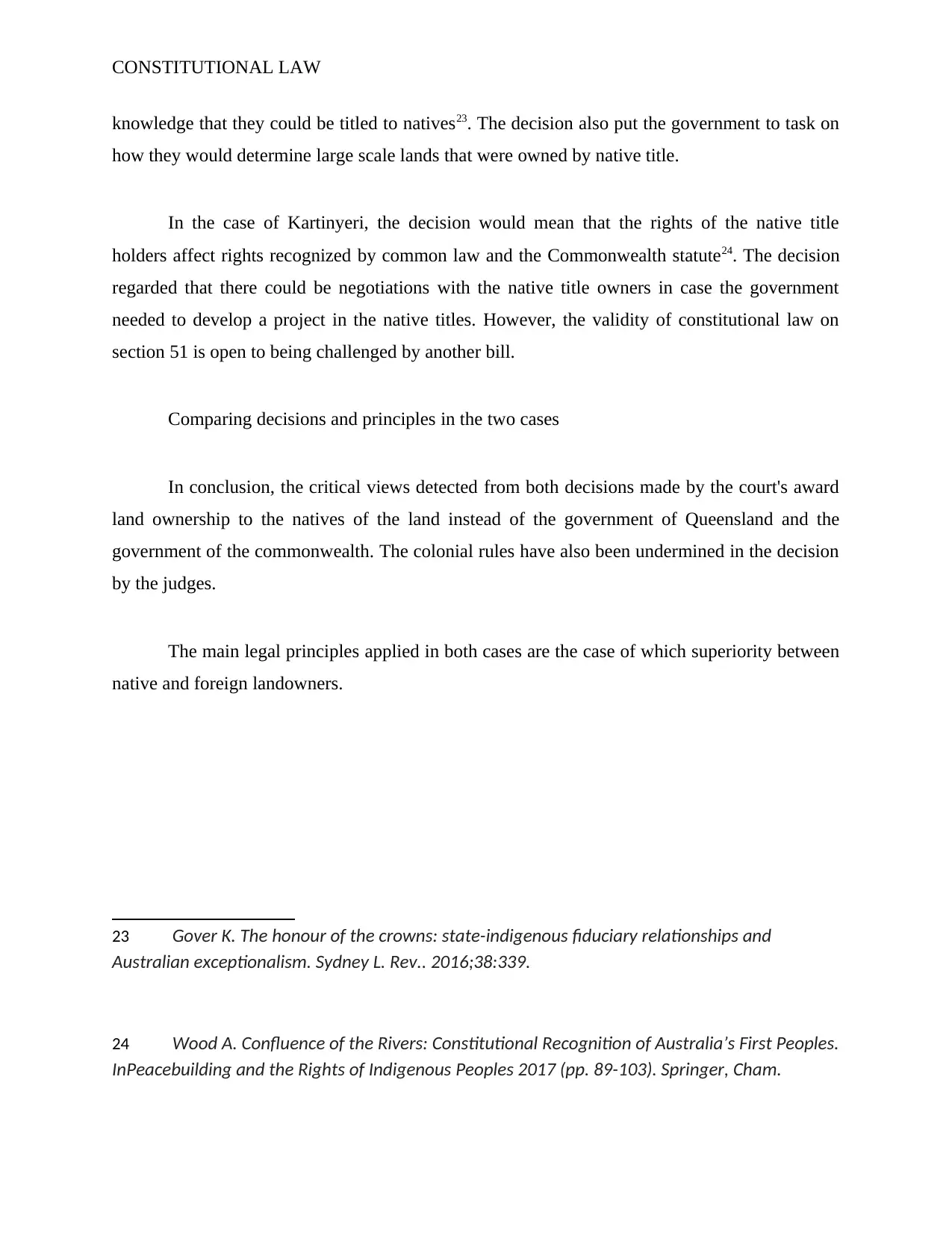
CONSTITUTIONAL LAW
knowledge that they could be titled to natives23. The decision also put the government to task on
how they would determine large scale lands that were owned by native title.
In the case of Kartinyeri, the decision would mean that the rights of the native title
holders affect rights recognized by common law and the Commonwealth statute24. The decision
regarded that there could be negotiations with the native title owners in case the government
needed to develop a project in the native titles. However, the validity of constitutional law on
section 51 is open to being challenged by another bill.
Comparing decisions and principles in the two cases
In conclusion, the critical views detected from both decisions made by the court's award
land ownership to the natives of the land instead of the government of Queensland and the
government of the commonwealth. The colonial rules have also been undermined in the decision
by the judges.
The main legal principles applied in both cases are the case of which superiority between
native and foreign landowners.
23 Gover K. The honour of the crowns: state-indigenous fiduciary relationships and
Australian exceptionalism. Sydney L. Rev.. 2016;38:339.
24 Wood A. Confluence of the Rivers: Constitutional Recognition of Australia’s First Peoples.
InPeacebuilding and the Rights of Indigenous Peoples 2017 (pp. 89-103). Springer, Cham.
knowledge that they could be titled to natives23. The decision also put the government to task on
how they would determine large scale lands that were owned by native title.
In the case of Kartinyeri, the decision would mean that the rights of the native title
holders affect rights recognized by common law and the Commonwealth statute24. The decision
regarded that there could be negotiations with the native title owners in case the government
needed to develop a project in the native titles. However, the validity of constitutional law on
section 51 is open to being challenged by another bill.
Comparing decisions and principles in the two cases
In conclusion, the critical views detected from both decisions made by the court's award
land ownership to the natives of the land instead of the government of Queensland and the
government of the commonwealth. The colonial rules have also been undermined in the decision
by the judges.
The main legal principles applied in both cases are the case of which superiority between
native and foreign landowners.
23 Gover K. The honour of the crowns: state-indigenous fiduciary relationships and
Australian exceptionalism. Sydney L. Rev.. 2016;38:339.
24 Wood A. Confluence of the Rivers: Constitutional Recognition of Australia’s First Peoples.
InPeacebuilding and the Rights of Indigenous Peoples 2017 (pp. 89-103). Springer, Cham.
⊘ This is a preview!⊘
Do you want full access?
Subscribe today to unlock all pages.

Trusted by 1+ million students worldwide
1 out of 16
Related Documents
Your All-in-One AI-Powered Toolkit for Academic Success.
+13062052269
info@desklib.com
Available 24*7 on WhatsApp / Email
![[object Object]](/_next/static/media/star-bottom.7253800d.svg)
Unlock your academic potential
Copyright © 2020–2025 A2Z Services. All Rights Reserved. Developed and managed by ZUCOL.




